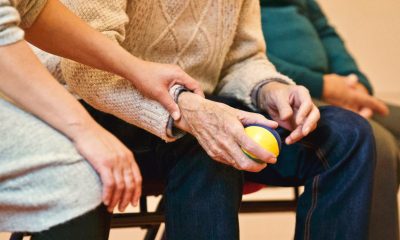Lifestyle
How to empower older adults to become digital citizens in our tech-dependent world

Living in a technology dependent world means we all want to stay connected, regardless of age. And the COVID-19 pandemic was a major catalyst for increasing our technological dependence.
It became normal to do weekly online grocery shops, attend doctors’ appointments or work via Zoom and FaceTime family and friends. The reality is however, that not everyone is fortunate enough to have access to the technological devices or skills to operate in our online world — some of the most impacted by this are older adults.
This magnified the pandemic for them, especially in terms of isolation. Older adults were left without the main resource that has been keeping many of us connected — technology.
But that’s not all the pandemic has laid bare for older adults. A large number of them are also either experiencing, or are vulnerable to homelessness. Older adults have become one of the groups most at-risk for housing insecurities during the pandemic. And one of the largest barriers to housing, is low socioeconomic status.
Our technological dependence has created new challenges for older adults, and helped solidify pre-existing ones, like navigating online platforms to secure housing. Older adults face housing barriers due to the lack of technological resources and education on how to use them; there is a clear need to empower them to be digital citizens.
Finding housing in an internet-dependent world
Overall, older adults are often excluded from using the internet because they lack devices and connectivity, or are inexperienced in using it. So when it comes to finding housing, they’re often left behind.
A decade ago, it was possible to walk through the streets, sift through newspapers, notice boards and discover apartments for rent, but this is increasingly uncommon. The platforms themselves — like Kijiji, PadMapper and Facebook Marketplace — are not made with older adults in mind; meaning the ability to navigate and access these resources makes it even more difficult for them to find housing. On top of having to search through unfamiliar platforms, they’re also faced with finding an apartment on a limited budget.
Imagine you don’t know housing websites exist. Or know how to navigate online ads. Or have a device to access the internet. You’re put at a serious disadvantage when it comes to accessing housing.
In North America “large portions of the rental housing market have moved online … more renters in urbanized areas found their current homes through a site like Craigslist than through any other information channel.” Meaning the majority of rental properties are accessible through online platforms. Older adults who are not part of this digital world have limited opportunities to find housing.
We don’t want to suggest that finding an apartment is impossible but, if you are an older adult lacking technological resources and digital literacy, it may feel overwhelming.
Making technology more accessible
How can we move forward in this digital world, when so many are being left behind? We should at least make technology accessible, so the choice is up to the user.
When it comes to older adults, having the liberty to choose their involvement with technology can provide independence and autonomy. When the decision is theirs to make, their quality of life tends to increase, especially regarding social isolation.
While older adults are more vulnerable to phishing and scams and may have trouble recognizing fake housing advertisements, having support and educational resources can promote the adoption of a conscious and cautious attitude online, promote the use of trusted websites and avoid disclosing personal information such as SIN and credit card information. This can actively enable older adults to feel more comfortable and confident online.
We are a part of the Aging in the Right Place (AIRP) Project which looks at the causes of homelessness for older adults in order to evaluate current promising practices in place, such as temporary housing that support older adults who are at risk of experiencing homelessness.
An integral part of this project is to not only be in close contact with the people working towards supporting this population, but also with older people experiencing homelessness themselves. In our preliminary client interviews of those living in the temporary housing, we’re often told how invaluable technology is when searching for stable housing.
Technology can improve quality of life
As a society we assume older adults are not interested in various technologies, not because they’re resisting but because technologies that currently exist were simply not created with them in mind. Failing to include older adults as technology users further perpetuates the social, information and digital exclusion they experience.
This leaves very few opportunities for them to access education and awareness. Opportunities that do exist to learn are often found in schools or at work — which are environments many older adults no longer frequent.
Technology can improve the quality of life for older adults by providing ease, inclusion and comfort by making the essentials, like finding housing, more accessible.
It’s time we draw on the resources and educational initiatives in place and reach out to the ones who have been left behind. Let’s empower older adults to be digital citizens.
As digital citizens, they will have more opportunities to secure housing and tools to prevent homelessness. These supports will not only give them a sense of involvement in a technologically dependent world, but also provide a sense of belonging and inclusion in today’s society.
Diana Juanita Mora, an undergraduate research assistant from Simon Fraser University, helped research and co-author this piece.![]()
![]()
Rachelle Patille, Research Assistant, Aging in the Right Place (AIRP), Simon Fraser University; Atiya Mahmood, Associate professor, Gerontology Department, Simon Fraser University, and Priscilla Ruth Chyrva, Assistant Researcher, Aging in the Right Place (AIRP), Simon Fraser University
This article is republished from The Conversation under a Creative Commons license. Read the original article.





















